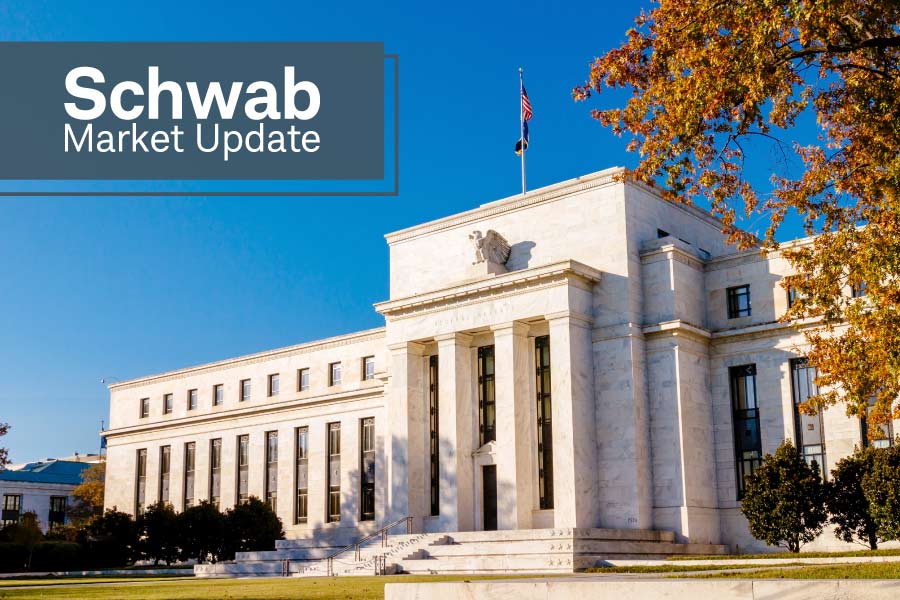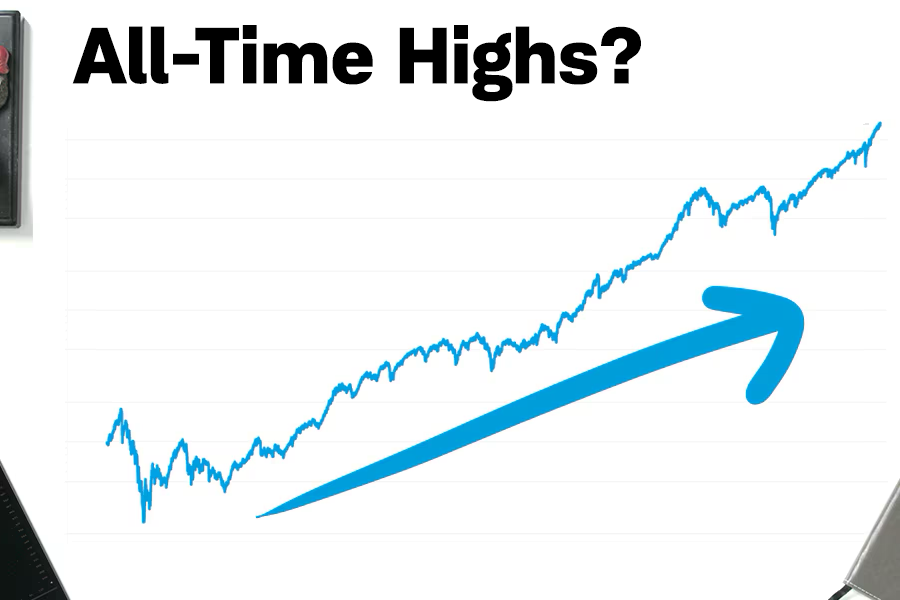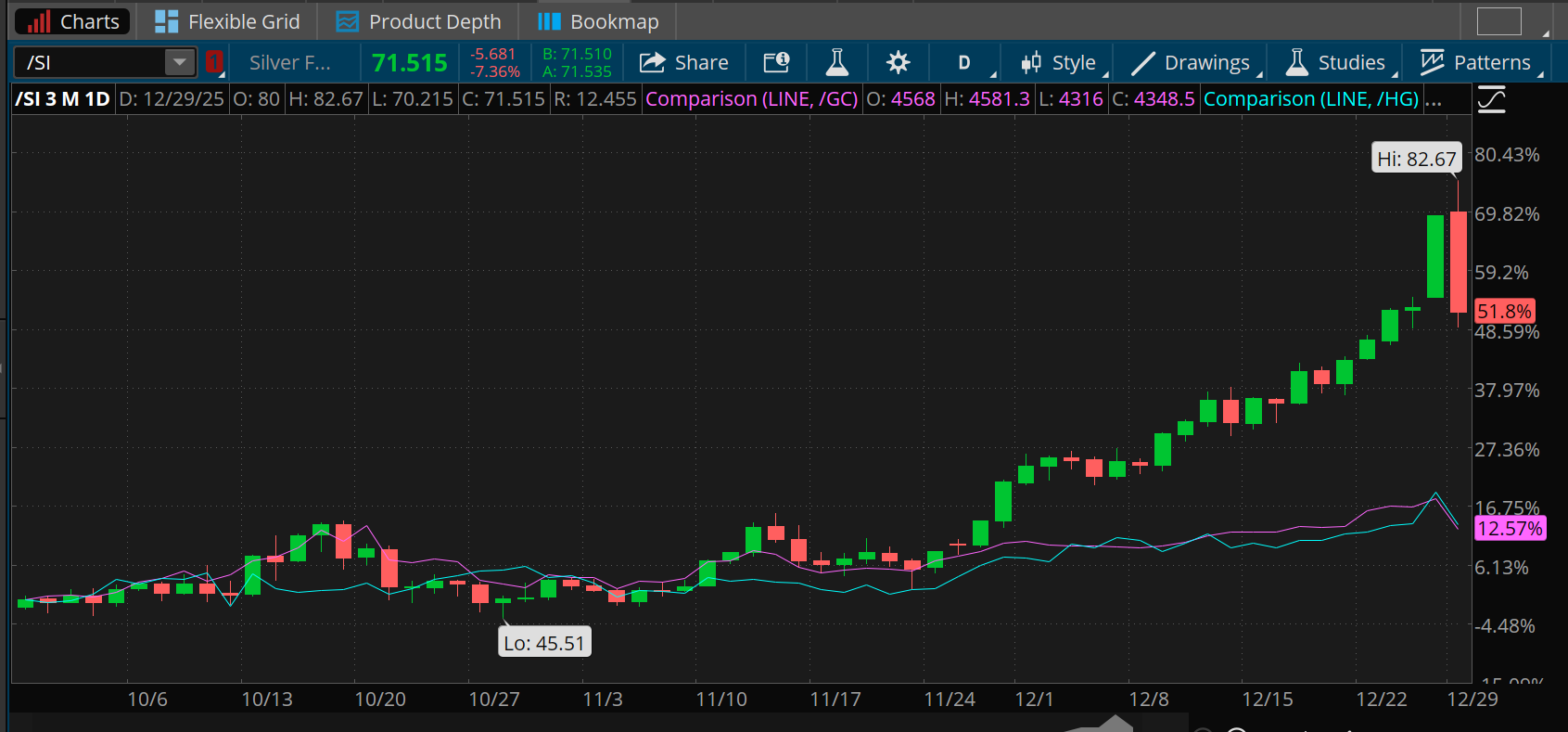Rate Debate: Fed Minutes Today Provide Inside Look

Published as of: December 30, 2025, 9:19 a.m. ET
Listen to this article
Listen here or subscribe for free to the Schwab Market Update in your favorite podcast app.
| The markets | Last price | Change | % change |
|---|---|---|---|
| S&P 500® index | 6,905.74 | –24.20 | –0.35% |
| Dow Jones Industrial Average® | 48,461.93 | –249.04 | –0.51% |
| Nasdaq Composite® | 23,474.35 | –118.75 | –0.50% |
| 10-year Treasury yield | 4.12% | +0.01 | -- |
| U.S. Dollar Index | 98.09 |
+0.05 |
+0.06% |
| Cboe Volatility Index® | 14.51 | +0.31 | +2.18% |
| WTI Crude Oil | $58.35 | +$0.27 | +0.45% |
| Bitcoin | $88,440 | +880 |
+1.01% |
(Tuesday market open) With data and earnings mostly on hiatus ahead of Thursday's New Year's Day market closure, investors turn this afternoon to the one major agenda item on today's calendar: minutes from the Federal Reserve's most recent meeting. Stocks flattened early Tuesday ahead of the release, with the S&P 500 index now up 17% year-to-date and the Nasdaq 100 (NDX) up 21.5%. The two leading sectors for 2025 approaching year-end are communication services and information technology, with industrials third.
Getting back to the minutes, it's possible they'll provide clarity on why Fed officials expect to slow the pace of rate cuts in 2026 after cutting rates three times since September. The Fed's "dot plot" of rate projections featured a median estimate of just one cut next year, though Treasuries trading bakes in two to three. "The meeting minutes will likely show a range of opinions about the outlook for Fed policy," said Cooper Howard, director of fixed income research and strategy at the Schwab Center for Financial Research. "With inflation running above target and the labor market slowing but not falling off a cliff, the Fed will likely move at a slow pace cutting rates. We still expect one or two more cuts next year."
Major indexes dipped Monday in trading that was about 25% lighter than normal. One source of pressure was geopolitical tension in the Middle East and Taiwan that continued today. Info tech stocks ran into profit taking and materials stocks fell yesterday as silver and gold reversed their recent rallies. Treasury yields finished down more than 2 basis points for the benchmark 10-year note, below 4.12% and near recent lows. This was despite a stronger-than-expected November pending home sales report released Monday. The drop in metals prices might have fended off some inflation fears, boosting Treasuries.
To get the Schwab Market Update in your inbox every morning, subscribe on Schwab.com.
Three things to watch
- Deeper dive ahead of Fed minutes: Any policy makers arguing at this month's meeting for steeper cuts might have justified that with concerns about employment, while those opposing any rate move might have pointed to inflation trends they're watching. Either argument detailed in the minutes would potentially offer investors deeper insight into what trends policy makers are monitoring and what to watch as economic data filter in. Speaking of which, the Fed's economic projections were quite rosy, and the minutes might provide thinking behind that, as well. How the Fed thinks growth can accelerate, unemployment can stabilize, and inflation can fall—a "Goldilocks" scenario—is something investors might try to glean. That's especially true considering the central bank noted rising unemployment, slower job gains, and "somewhat elevated" inflation this year. Downside risks to employment, the Fed said in its December 10 statement from the meeting, have risen.
- Homes for the holidays: Today does offer some economic data. Notably, the October FHFA Housing Price Index and October S&P Cotality Case-Shiller Home Price Index both came out shortly before the open, with FHFA rising 0.4%, above the Briefing.com consensus of 0.1% month over month. The 20-city composite Cotality Index rose 1.3%, above the 1.1% year-over-year consensus. Annual home price growth is down from 1.4% in September and near two-year lows. If this trend continues, it might suggest the light demand seen in recent months could finally be translating into slower price growth, though home prices remain at all-time highs, partially due to slim supplies and because the home market has also become a target for investors.
- China manufacturing read ahead: Overseas data loom early Wednesday when China releases its official NBS Manufacturing numbers for December. The headline manufacturing figure has held below 50 for eight straight months, meaning a contraction in factory activity. This partially signals lighter demand for Chinese exports, which often reflects economic trends in Europe and the U.S.—major export markets for Chinese goods. Europe and China are in a trade battle after Beijing imposed tariffs on EU dairy products last week to counter EU tariffs against Chinese EVs. U.S. trade relations with China wax and wane. On one hand, shares of Nvidia (NVDA) and Advanced Micro Devices (AMD) rose last week in part on news that Chinese firms might be ready to buy their chips. On the other, China levied new trade restrictions against U.S. defense firms after the Trump administration sold weapons to Taiwan, and tension in that region surfaced again today as Reuters reported that China has fired missiles into waters off Taiwan. China's economy still wrestles with an excess supply problem accompanied by light domestic demand. Fixed asset investment in China fell 2.6% between January and November, the first annual decline since at least 1998, Bloomberg reported.
On the move
Applied Digital (APLD) climbed nearly 2% ahead of the open after the company entered a non-binding term sheet to spin out its cloud computing business, Applied Digital Cloud, and combine it with Ekso Bionics Holdings (EKSO). Shares of Ekso jumped more than 40%.
Semiconductor stocks generally climbed before Tuesday's open, led by ASML (ASML) and Micron (MU). The latter is one of the best performing stocks on Wall Street this year, with gains of nearly 250%.
Tech giants Nvidia, Broadcom (AVGO), and Oracle (ORCL) are licking their wounds after yesterday's drop, which may have reflected profit taking. Typically, this sort of action around the new year occurs in January, which allows investors to postpone paying capital gains taxes. All are up fractionally this morning.
Meta Platforms (META) fell slightly after the Wall Street Journal reported the company is paying more than $2 billion to acquire Singapore-based AI startup Manus.
Bitcoin (/BTC) inched up early Tuesday but remains shy of the $90,000 mark and down 6% for the year.
Silver futures (/SI) rebounded more than 7% early Tuesday after falling about that much Monday. They remain below record highs above $80 reached earlier this week, however. The sharp rally in silver this year, in which it's up more than 150%, raises inflation concerns because the metal is used in many industrial processes. From a technical standpoint, silver looked over-extended even after Monday's drop, trading 31% above its 50-day moving average and 70% above its 200-day moving average.
Tesla (TSLA) fell more than 3% Monday, after Tesla's CEO Elon Musk warned of high silver prices potentially raising the cost of industrial production. The drop could also represent profit taking after the stock's recent record high. Shares are up 7% over the last month ahead of potential 2026 catalysts including a broader robotaxi rollout, new product launches, and a potential SpaceX initial public offering.
Mining stocks that rallied last week on gold's strength went the opposite way Monday, with Freeport McMoRan (FCX) falling 2.9% and Newmont (NEM) dropping 5.8%. Materials was the weakest sector on Monday.
On Tuesday, fortunes reversed as Newmont climbed 1.8% and silver producer Hecla Mining (HL) rose 2.6% on the back of silver and gold's rebound. Freeport McMoRan rose 1.8%.
Crude oil futures (/CL) climbed nearly 0.5% early Tuesday as investors eyed potential roadblocks in the Ukraine peace talks, fresh warnings aimed at Iran from President Trump, and an OPEC meeting this coming weekend at which the cartel is expected to keep production unchanged, according to Bloomberg.
Treasury yields fell more than 2 basis points Monday for the benchmark 10-year note, below 4.11% and near recent lows. This was despite a stronger-than-expected November pending home sales report released Monday. The drop in metals prices might have fended off some inflation fears, boosting Treasuries, which move opposite of yields. The 10-year yield rebounded early Tuesday as commodity prices rose and the Chinese yuan climbed against the dollar.
Lululemon Athletica (LULU) climbed 1.7% Monday after its founder said he had launched a proxy fight by nominating three independent directors to the company's board, CNBC reported.
Futures trading prices in 16% odds of a January rate cut as of early today, according to the CME FedWatch Tool. Chances have fallen since last week's surprisingly firm U.S. third quarter Gross Domestic Product (GDP) report. Market participants see growing chances of a rate cut by the time of the Fed's March meeting, where chances are roughly 50% that rates will be down at least a quarter point from the current 3.5% to 3.75%.
More insights from Schwab

High-altitude investing: Major U.S. indexes hit record highs last week, raising the question of how investors might want to approach the market at these levels. Schwab's video, Investing During Stock Market Highs, explains why these times might be a good chance to examine risk in your portfolio.
Chart of the day

Data source: CME Group. Chart source: thinkorswim® platform.
Past performance is no guarantee of future results.
For illustrative purposes only.
Though gold (/GC–purple line) captures most of the headlines, silver futures (/SI–candlesticks) have made the bigger move over the last three months, rising more than 50% even after Monday's sharp reversal from record highs. The sharp downturn in silver and gold yesterday hurt materials sector stocks, but shares have spiked over the last year as industrial demand boosted prices of silver and copper (/HG–blue line).
The week ahead
Check out the investors' calendar for a summary of the top economic events and earnings reports on tap this week.
December 31: EIA crude oil inventories.
January 1: No major earnings or data expected. New Year's Day holiday.
January 2: November construction spending.
January 5: December ISM Manufacturing PMI.
January 6: No major data or earnings expected.